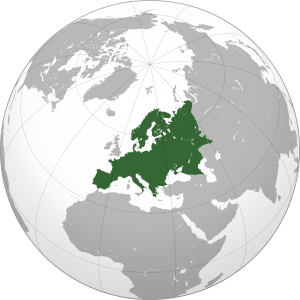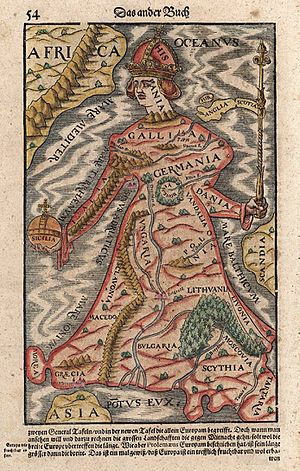Continental Europe facts for kids
Continental Europe, also called mainland Europe, is the main part of the continent of Europe. It means Europe without its many islands. Think of it as the big land area that most European countries are on.
When people talk about continental Europe, they usually mean the land without islands like the Greek Islands, Malta, Sicily, Sardinia, Corsica, the Balearic Islands, Iceland, Ireland, and the United Kingdom. The eastern edge of this huge landmass is often seen as the Ural Mountains, the Ural River, the Caspian Sea, and the Caucasus Mountains.
Contents
What is "The Continent" to People in the UK?
In the United Kingdom, people often say "the Continent" to mean the main part of Europe. They use this term to show that they are separate from the mainland. Sometimes, even the word "Europe" itself is used to mean Europe without Great Britain, Iceland, and Ireland.
The word continental can also describe things that are common in mainland Europe but different in Britain. For example, a "continental breakfast" is a type of breakfast common there. There are many differences between Britain and continental Europe. These include:
- Different types of laws (Civil Law versus Common Law).
- Different electrical plugs.
- Most countries are in different time zones.
- Many use the Euro currency.
- People drive on the right side of the road (in Britain, they drive on the left).
- They use the Metric system for measurements.
In Scandinavia, "continental" often means Europe without the Scandinavian peninsula, Britain, Ireland, and Iceland. Even though the Scandinavian peninsula is connected to the rest of Europe by land, people usually travel there by sea. This is because going by land would mean traveling very far north.
In Sweden, people say Kontinenten (meaning "the Continent") to talk about the area without Sweden, Norway, and Finland. This term includes Denmark and the rest of mainland Europe. Similarly, in Norway, Kontinentet usually refers to countries like Germany, France, Italy, Spain, Portugal, and the Benelux countries (Belgium, Netherlands, Luxembourg).
Islands and the Mainland
Sometimes, "the Continent" can mean just the mainland part of a country that also has islands. For example:
- For people in Sardinia or Sicily, "the Continent" means the mainland of Italy.
- For those in the Balearic Islands or Canary Islands, it means the mainland of Spain.
- For people in Corsica, it means the mainland of France.
- For those in the Madeira Islands or Azores, it means the mainland of Portugal.
- For people on the Ionian Islands or Crete, it means the mainland of Greece.
This term helps island residents talk about the main part of their country or the larger European landmass.
Images for kids
-
The eastern part of Europe in Russia, stretching to the Ural Mountains and bordered by the Caucasus Mountains in the south.
See also
 In Spanish: Europa continental para niños
In Spanish: Europa continental para niños






